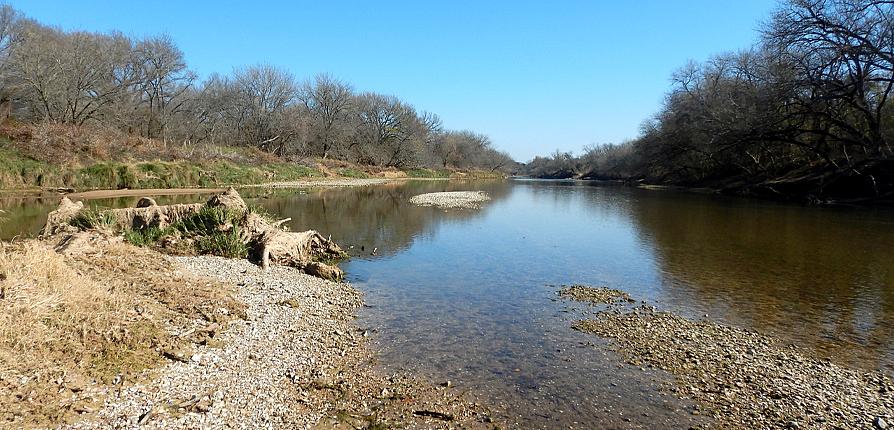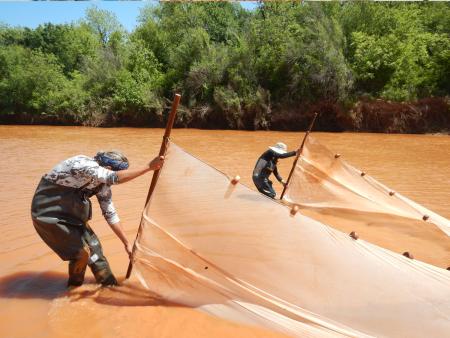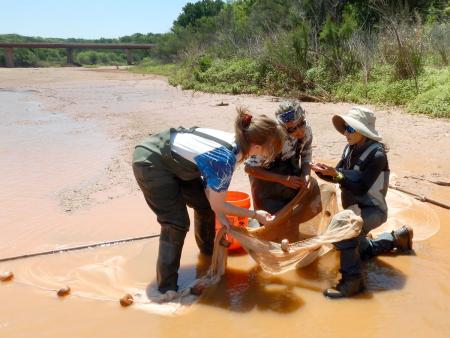Multiple habitats were sampled in the middle Brazos River in McLennan County, Texas, in December 2020. Fish found at these sampling sites underwent analysis of morphology, stomach contents and stable isotopes.
Native fish suffer at the fins of invasive counterparts
Story by Alyssa Faykus '19
Photos Courtesy of Erin Shepta '22
Illustrations by Kubs Sabrsula-Mendoza '17
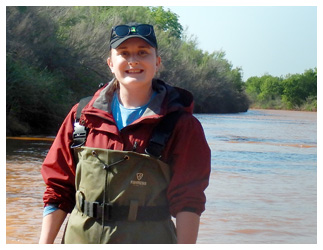
Invasive species of fish are detrimental to native fish populations, including inland Texas waterways like the Brazos and Red rivers. From competition for resources and predation to habitat alteration and ecosystem imbalance, invasive species, like the sheepshead minnow and Gulf killifish, are known threats in Texas.
A grant from the Texas Parks and Wildlife Department funding research for the origins of these invasive fish drew Erin Shepta '22 to SFA. Arriving in August 2020 from Millersville University in Pennsylvania, her time at SFA as a graduate biology student was spent fishing, sampling, analyzing data and writing about invasive fish — a research quandary she is particularly invested in.
"I started studying invasive species in my undergrad and became very interested in it after I graduated," Shepta said. "I was really entrenched in fieldwork with invasive species. When I was browsing a job board, I saw this really cool project with invasive fish — I had never worked with fish before, but I liked the invasive species aspect of it and applied."
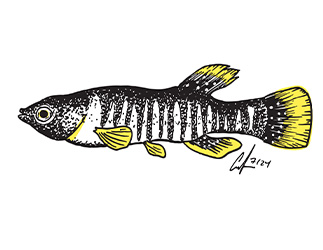
Dr. Carmen Montaña-Schalk, SFA assistant professor of biology, develops and submits research proposals to different state and federal agencies to get grant funding for graduate research positions for her lab, Montaña Aquatic Ecology Lab. These grants attract outstanding graduate students like Shepta, according to Montaña-Schalk.
"Graduate students funded through research assistantships are paid to work on their thesis project while meeting the objectives of the project funded by these external partners," Montaña-Schalk said.
These grants make it affordable for students like Shepta to not only pursue their dreams and build their portfolios but also build meaningful connections in the industry — all before walking the graduation stage.
Invasion of inland waters
Shepta's thesis, "Assessing the Live Bait Industry and the Ecological Status of Invasive Cyprinodontiformes in Texas Streams," explores the possible ways these fish are introduced, as well as how they impact native populations of fish, like the Red River pupfish.
During her graduate program at SFA, the first question Shepta was asked to answer was how these invasive species of fish are entering inland Texas waterways.
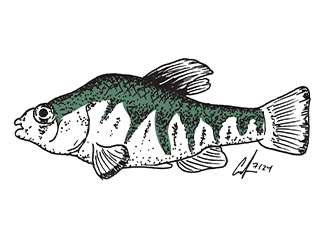
"There were two smaller species of fish that had been introduced into inland rivers in Texas, and TPWD wanted to know why," she said. "They knew these fish had impacted other basins, and they were wondering what's going on: How are these fish being introduced? Why are they being spread? They were really worried about what kinds of impacts these fish could have in these newly introduced rivers."
TPWD's theory was that the fish were being sold as baitfish, and that's why they were being spread.
"That was the first chapter of the research — calling and visiting bait shops and trying to find these fish. We did not find them, which is good and bad," Shepta said.
"The second chapter focused on the impacts, especially for the Red River pupfish." she said. "That's a native threatened fish. We used a lot of different techniques to find the different impacts on native fish. This proof shows invasive species are really affecting our native waters."
The right mentor
Shepta's research is one of the first studies conducted in Texas that investigates the potential pathways of two invasive coastal species introduced to Brazos River inland waters. Montaña-Schalk conducts research in the two rivers where Shepta also worked — the Brazos and Red rivers in Texas. Research is ongoing to determine further the impacts of these invasive species.
"Results from Erin's project have allowed continual monitoring of the fish-diversity rivers of Texas," Montaña-Schalk said. "We are monitoring the fish communities through time and space, evaluating the presence of the native and nonnative species. Most importantly, we are examining the distribution and current status of endangered and threatened fish species within these river basins."
Montaña-Schalk said Shepta was an outstanding, dedicated student who served as a mentor to undergraduate students during her time at SFA.
"Dr. Montaña-Schalk drew me to the program," Shepta said. "A lot of times, how it works in the STEM fields is a professor will advertise a position. I had never heard of SFA — it's very far away from where I'm from — but Dr. Montaña-Schalk posted [my research position] on the Texas A&M job board, which a lot of people in my field use for graduate positions, and it seemed like a really great opportunity to do this research project that drew me to the school."
Arriving in Texas for the first time in her life, Shepta didn't know what to expect. But Montaña-Schalk quickly introduced her to field research, and she fell in love with it.
"Texas is crazy with the different ecosystems that go across it," Shepta said. "I had never been anywhere like the Brazos River. It was completely new, and I had to start learning about what fish were there, what different ecosystems were like and really, I just got thrown into it."
The hands-on learning involved in fishing and collecting samples helped Shepta gain needed real-world experience.
"Montaña-Schalk is a very hard-working lady, and she loves being in the field," she said. "She felt good about immediately taking me into the field with her, so it was a learn-on-your-feet experience. We started sampling in the river, and that was very valuable to me because I didn't have much experience in the field before."
Shepta is continuing her education at West Virginia University pursuing a doctorate in natural resource sciences — a path she discovered while at SFA.
"Dr. Montaña-Schalk pushed me to become a better scientist," she said. "Going into SFA, I wasn't sure what I wanted to do. I thought about academia or other fields, but by the time I left, I was certain that I wanted to pursue a PhD."
"[Montaña-Schalk] helped me learn how to conduct science and fall in love with research and see that this is what I want to do: work in research."
Shepta completed her 168-page thesis in under two years after four sampling seasons in the rivers.
"The first year, I was going into the river, getting fish and taking the fish back to the lab," Shepta said. "We took measurements and tissue samples and stomach contents. Then I transitioned into writing. I wrote this whole thing over the course of six to seven months."
Carpe diem
Sitting in a small office with no windows, illuminated only by the glow of her computer, Shepta had a sparkle in her eyes talking about her future career as a statistical analyst for invasive carp in the Ohio River, which is her next big project while pursuing her doctoral degree.
"I am two years into my PhD program, and it's hopefully my halfway point," she said. "I'm really excited about the research I'm doing here. I love statistics, and I dived head-first into that here."
Shepta said she's applying what she learned at SFA on a larger scale.
"There's a lot of funding right now to help slow invasive fish spread," Shepta said. "I'm so excited to take on a huge-scale project like this in the Ohio River, one of the biggest affluents to the Mississippi River, which is the largest river. I love the scale of it. I'm very interested to see what kind of results we get."
After adding "Dr." to her title, Shepta hopes to land a federal or state position and continue research through data analysis.

 Axe ’Em, Jacks!
Axe ’Em, Jacks!
